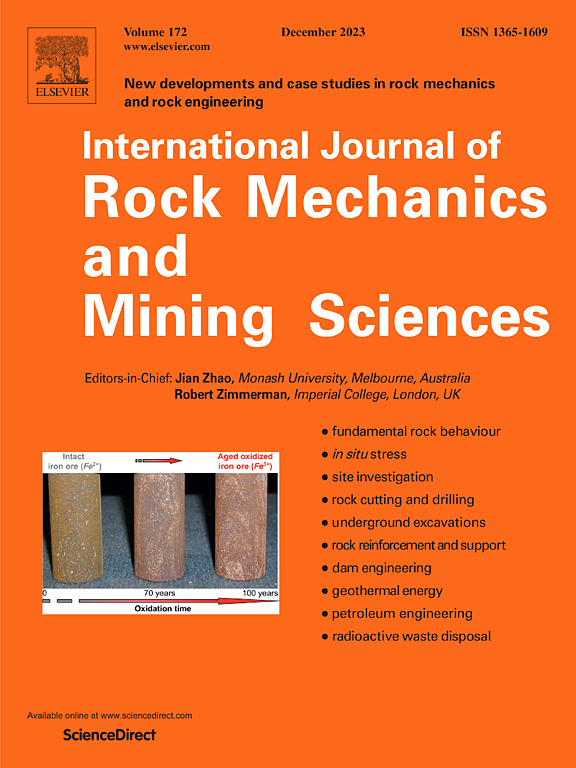基于深度学习的岩石裂纹张开位移自适应去噪方法
IF 7
1区 工程技术
Q1 ENGINEERING, GEOLOGICAL
International Journal of Rock Mechanics and Mining Sciences
Pub Date : 2025-04-10
DOI:10.1016/j.ijrmms.2025.106112
引用次数: 0
摘要
为了保证地质处置设施等关键隐伏岩体结构的安全,需要对裂缝张开位移(COD)进行精确预测,将其控制在一定的阈值范围内,目前岩石COD的估算多采用分布式光纤传感(DFOS)数据。从DFOS数据计算工程结构COD的常用方法是基于应变传递的解析模型。然而,当DFOS数据显示出高水平的噪声时,这些分析模型在计算COD方面面临重大挑战。针对这一局限性,本研究旨在开发深度注意阈值处理网络(deep attention threshold processing network, DATPN),以提高高噪声DFOS数据的特征提取能力,准确预测岩石COD。首先设计信道关注模块作为DATPN的主模块,自动学习适应不同噪声的阈值,从而在确定噪声阈值时不需要专业知识。然后将学习到的噪声阈值提供给内置的改进的DATPN阈值函数,以消除数据噪声。因此,由于消除了数据噪声,DATPN可以很容易地学习到更多有用的目标特征,从而准确预测岩石COD。结果表明,当使用原始测量数据集进行评估时,所提出的DATPN的最大拟合优度(R2)为0.9924,最小均方误差为5.22,COD预测的百分比误差在±10%以内。在信噪比为0的数据集上,DATPN的R2、相关系数、均方根误差和标准差(0.8407、0.9193、10.31和24.37)均优于其他四种机器学习模型。这表明DATPN在高噪声DFOS数据中预测岩石COD是令人满意的。本文章由计算机程序翻译,如有差异,请以英文原文为准。

Deep learning-based adaptive denoising method for prediction of crack opening displacement of rock from noisy strain data
Precise prediction of crack opening displacement (COD) is necessary to control it within a certain threshold to ensure safety of critical buried rock structures (e.g. geological disposal facilities), and rock COD nowadays tends to be estimated using distributed fiber optic sensing (DFOS) data. The frequently used methods for computing COD of engineering structures from DFOS data are based on analytical models derived from strain transferring. However, these analytical models face significant challenges in computing COD when DFOS data exhibits high levels of noise. To address this limitation, this research aims to develop a deep attention threshold processing network (DATPN) to improve feature extraction ability from highly noisy DFOS data and accurately predict the COD of rock. A channel attention module is firstly designed and used as the main module by the DATPN to automatically learn thresholds adapting to different noises, so that the professional expertise is not required when determining noise thresholds. The learned noise thresholds are then provided to a built-in improved thresholding functions of the DATPN to eliminate data noise. Therefore, the DATPN can easily learn more useful target features to accurately predict the COD of rock owing to the elimination of data noise. The results indicate that the proposed DATPN achieves a maximal goodness of fit (R2) of 0.9924, a minimal mean squared error of 5.22, and a percent error for COD prediction ranging within ±10 % when evaluated using the original measured dataset. The R2, correlation coefficient, root-mean-square error, and standard deviation for the DATPN (0.8407, 0.9193, 10.31, and 24.37) are superior to the other four machine learning models on the dataset with a signal-to-noise ratio of 0. This demonstrates that the DATPN is satisfactory in predicting the COD of rock from highly noisy DFOS data.
求助全文
通过发布文献求助,成功后即可免费获取论文全文。
去求助
来源期刊
CiteScore
14.00
自引率
5.60%
发文量
196
审稿时长
18 weeks
期刊介绍:
The International Journal of Rock Mechanics and Mining Sciences focuses on original research, new developments, site measurements, and case studies within the fields of rock mechanics and rock engineering. Serving as an international platform, it showcases high-quality papers addressing rock mechanics and the application of its principles and techniques in mining and civil engineering projects situated on or within rock masses. These projects encompass a wide range, including slopes, open-pit mines, quarries, shafts, tunnels, caverns, underground mines, metro systems, dams, hydro-electric stations, geothermal energy, petroleum engineering, and radioactive waste disposal. The journal welcomes submissions on various topics, with particular interest in theoretical advancements, analytical and numerical methods, rock testing, site investigation, and case studies.

 求助内容:
求助内容: 应助结果提醒方式:
应助结果提醒方式:


